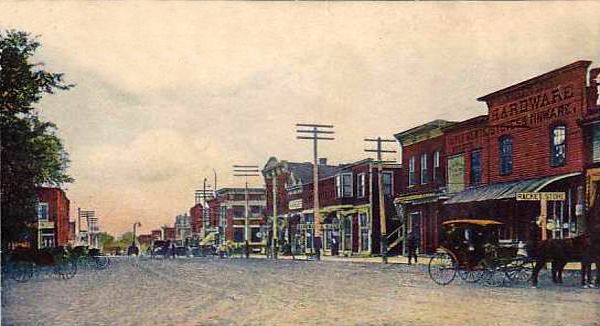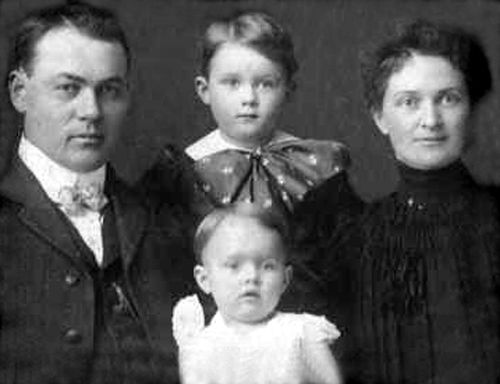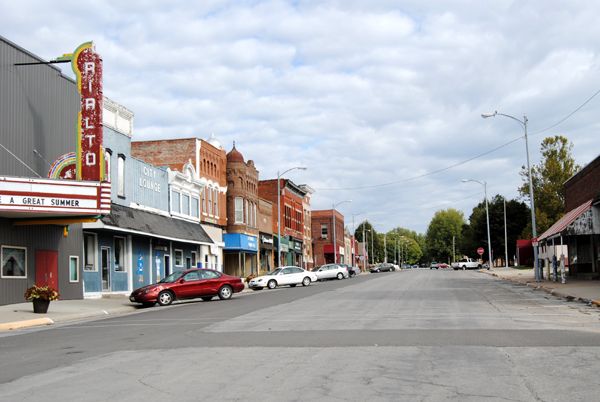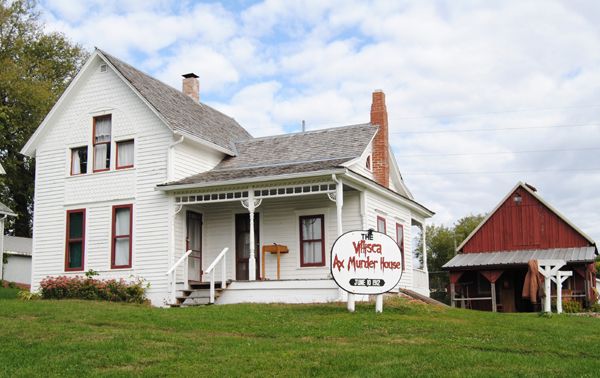Villisca, Iowa and the Axe-Murder Man – Legends of America (original) (raw)
Postcard of Villisca, Iowa, in the early 1900s.
On a quiet residential street in the small town of Villisca, Iowa, a horrible tragedy that continues to affect this small town occurred a century ago. The walls of this pristine home still protect the identity of a murderer who bludgeoned the entire family of Josiah Moore and two overnight guests on June 10, 1912. Moreover, not only do her walls hold the secret of the killer these many years later, but they also continue to house several paranormal entities.
Nestled in the hills of southwest Iowa, Villisca is a small rural community of about 1,300 people today, but in the early 1900s, it was a bustling railroad town with about 2,500 people.
At that time, more than two dozen passenger and freight trains stopped at the depot daily, and the town sported several hotels, restaurants, stores, theaters, and manufacturers. Josiah B. Moore, one of Villisca’s most prominent businessmen, lived in this thriving environment. The owner and operator of the Moore Implement Company (a John Deere Company franchise), he was a solid competitor with other area businesses. On December 6, 1899, Josiah married Sarah Montgomery at her parents’ home, and the couple would have four children – Herman, Katherine, Boyd, and Paul.
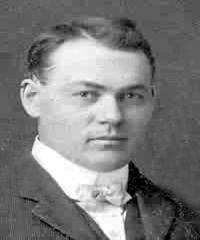
Josiah Moore
“J.B.,” as Josiah was familiarly called, and his wife, Sarah, were well-liked in the community, active in Presbyterian Church, and described as being friendly and helpful to their neighbors. On Sunday, June 9, 1912, the Moore and Stillinger families attended church. An annual event was also held Sunday evening called the “Children’s Day Program,” which had been coordinated by Sarah Moore. That evening, nine-year-old Katherine Moore invited her friends, 12-year-old Lena Stillinger and her sister, seven-year-old Ina May, for a sleepover. The girls accepted, and after the program ended at 9:30 p.m., the Moore family and the Stillinger sisters walked home from the church, arriving about 9:45 and 10:00 p.m.
The following day, Moore’s neighbor, Mary Peckham, noticed that the Moores were not outside taking care of their regular chores and that the house was unusually still. She knocked on the door between 7:00 and 8:00 a.m. but received no answer. When she tried to open the door, she found it locked. Concerned, she called Josiah’s brother, Ross Moore. When Ross Moore arrived, he knocked loudly on the door and shouted, attempting to raise someone inside the house. He then tried to look through the windows but found all the curtains drawn or the windows covered. He then produced his keys and entered the house, quickly returning to the front porch and instructing Mary Peckham to call the sheriff.
What he had seen was shocking. The entire Joshiah Moore family had been murdered, as well as the two young overnight guests – all bludgeoned with an axe while they slept. In the upstairs master bedroom lay 43-year-old Josiah Moore and 39-year-old Sara Moore, both bludgeoned in the head, their bed linens stained heavily with blood. In the adjacent upstairs bedrooms were the Moore children, 11-year-old Herman, ten-year-old Mary Katherine, seven-year-old Boyd, and five-year-old Paul, who had also been bludgeoned in the head while they slept. In the main level guest room, the bodies of Lena Stillinger, age 12, and her sister Ina, age eight, were also found dead, killed like the family.
Josiah Moore’s family in about 1904, before the two younger boys were born.
Villisca City Marshall Hank Horton arrived quickly, soon followed by other officers. In the meantime, the gruesome news spread like wildfire, and within no time, neighbors and curious onlookers converged on the house. Law enforcement quickly lost control of the crime scene, and it is said that as many as a hundred gawkers strolled through the house before the Villisca National Guard arrived around noon and cordoned off the home.
The investigation tells that the eight victims were killed shortly after midnight, and all but Lena Stillinger were thought to have been asleep at the time of their murders. It was concluded that Lena was the only victim who had attempted to fight off her attacker, as she appeared to have had a defensive wound on her arm. The attack was so vicious that the ceilings in the parents and children’s bedrooms showed gouge marks made by the upswing of the axe.
The axe was found in the guest bedroom, indicating that the Stillinger girls were the last to be killed. It was bloody, but an attempt had been made to wipe it off. The axe belonged to Josiah Moore. All of the curtains in the house had been drawn. Two windows that didn’t have curtains had been covered with clothing.
After being killed, all the victims’ faces were covered with bed linens or clothing. Other evidence showed that a pan of bloody water was discovered on the kitchen table and a plate of uneaten food.
No one could imagine who could commit such a heinous crime, and the townsfolk were first convinced it must be a deranged tramp. Expecting to find the blood-drenched killer hiding somewhere in the area, several posses were formed on horseback and in autos, searching alleys in the city and every barn, shed, and outhouse nearby. But, they returned empty-handed.
With darkness came the fear that a madman was on the loose and might strike again. Families partnered with neighbors to stand shotgun guard all night, and windows were nailed shut. In the ensuing days, every lock in town was sold out, residents openly carried weapons, neighbors looked suspiciously upon neighbors, and rumors and accusations ran rampant. Soon, newspaper reporters and private detectives flooded the streets. Bloodhounds were brought in, and law enforcement agencies from neighboring counties and states joined forces. The murders began a chain of events that split the small town and forever changed the lives of its residents.
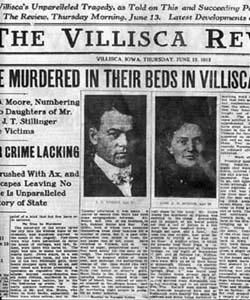
Villisca Newspaper
One of the earliest thoughts by investigators was the possibility of a serial killer. The previous year, a series of horrible murders occurred in the Midwest. In the fall of 1911, whole families were slaughtered in their beds every two weeks without apparent reason. These included the families of the Burnhams and the Waynes in Colorado Springs in September, the killing of a family in Monmouth, Illinois, two weeks later, culminating in the murder of the Showman family in Ellsworth, Kansas, on October 15, 1911. The following year, another similar murder occurred in Paola, Kansas, on June 5, 1912, just four days before Villisca. Despite similarities in these gruesome killings, interest in the serial killer theory soon faded and was largely forgotten.
Every stranger or transient to the small town was also suspect. One such man was Andy Sawyer. A transient who moved from job to job, he gained temporary work for the Burlington Railroad on the morning of the murder. According to the rail crew, he purchased a newspaper that headlined the murders and “was much interested in it.” The crew also complained that Sawyer slept with his clothes on with an axe nearby and was a loner. Afterward, he talked much about the Villisca murders and whether or not a killer had been apprehended. He also told the crew foreman that he had been in Villisca that Sunday night and was afraid he might be a suspect, so he left.
The crew’s foreman, Thomas Dyer, was suspicious and turned him over to the sheriff on June 18, 1912. The foreman would later testify that before he turned Sawyer over to authorities, he walked up behind him, and Sawyer was rubbing his head with both hands. Suddenly, he jumped up and said to himself, “I will cut your goddamn heads off,” while making striking motions with his axe and hitting the piles before him.
Though Sawyer’s name often came up in Grand Jury testimonies, he was eventually dismissed as it was found that he was actually in Osceola, Iowa, on the night of the murder. The alibi was very tight as he had been arrested for vagrancy at 11:00 p.m. that evening.
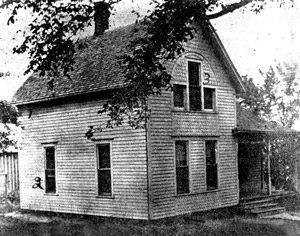
Josiah Moore’s home on June 10, 1912.
As the investigation continued, the focus turned to locals in the community, and several possible suspects emerged. The speculation of the townspeople caused them to identify themselves by who they believed committed the crime. Friendships became strained and, in many cases, irretrievably broken.
One of the first suspects was Sarah’s brother-in-law, Lee Van Gilder, who was her sister’s ex-husband, Mary. A man prone to violence and having previous brushes with the law, there was bad blood between him and the family. Van Gilder, however, was later cleared.
Looking at motive, the authorities began investigating Frank F. Jones, a prominent businessman and Iowa State Senator. For years, before he opened his own business, Josiah Moore had worked for Frank Jones as a top salesman in Jones of Villisca, a hardware and implement store. In 1907, Josiah left the company and started a competing business, taking the coveted John Deere franchise with him. The two became bitter enemies, so much so that by 1910, they wouldn’t speak and cross the street to avoid meeting each other.
Not believing that Jones would commit the crime himself, investigators began to look at a man named William Mansfield, who, from a “tip,” had learned Senator Frank F. Jones might have hired him to murder the Moore family. In July 1916, Mansfield was arrested in Kansas City, Kansas, and extradited to Iowa to face a Montgomery County Grand Jury. Though local opinion anticipated Mansfield would be bound over for trial, the jury refused to indict him because his alibi was checked out. In the meantime, Frank Jones lost his re-election as a senator but was never charged with a crime.
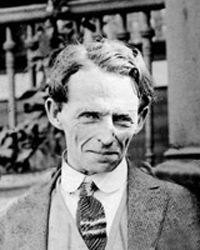
Reverend George Kelly
Another suspect was the Reverend George Kelly, a traveling minister who happened to be teaching at the Children’s Day services at the Presbyterian church, which the Moore family attended on June 9, 1912. The tiny, nervous, bird-like preacher had a reputation for being unbalanced and perhaps a pedophile and had left Villisca very early on the day of the murder. It was not these facts, however, that led to his being investigated.
Rather, it was an obsession that he had with the murder that turned law enforcement’s eyes on him. His obsession resulted in a stream of long, rambling letters sent to state and local investigators, private detectives, and relatives of the victims.
On his next preaching visit to Villisca two weeks after the crime, he arranged to stay over on Monday and visit the murder house. Within a month, officials began investigating him, finding out that he had been seen peeking into a woman’s bedroom just days before the murder and had been observed in several towns prowling streets late at night. He had also requested that young women pose nude for him on at least three occasions. They also cited a disturbed mental state, including his sexual obsession and a bloody shirt he sent to be laundered the week after the murder.
Kelly was arrested in April 1917. As the trial drew near, state officials decided on one final all-out effort to get him to confess. After a long evening of interrogation, Kelly dictated a confession on August 31, 1917. The confession stated that he had difficulty sleeping the murder night and went for a walk, during which he spied the Stillinger girls getting ready for bed through the window. He then said he heard the Lord’s voice commanding him to “suffer the children to come unto me.”
The trial began on September 4, 1917, but was dismissed on September 28 as the jury was deadlocked eleven to one for acquittal. A second trial in November resulted in Kelly being acquitted of all charges.
By the time the trial began, most Montgomery County citizens were convinced that Kelly was being framed as part of a conspiracy led by Frank Jones. They believed Jones had tried to pack the jury with his money and influence.
Another suspect was Henry Lee Moore (no relation to Josiah Moore), who was thought to be a serial killer. Several months after the Villisca murder, Henry was convicted of the murder of his mother and grandmother with an axe. He was also suspected of the killings in Colorado Springs, Colorado, and Ellsworth and Paola, Kansas. The cases were similar enough that the same person committed all; however, this was never proven.
In the end, the police and investigators gave up in 1917. The murders remained unsolved, and the killer went unpunished. Today, the remains of those murdered by the mysterious axe man lie in the Villisca Cemetery. The “Murder House” continues to stand.
Villisca is a small agricultural town of about 1,300 people today, by Kathy Alexander.
The house where the murders occurred was initially built in 1868, and the Moore family purchased it in 1903. After their deaths, the house went through the possession of eight people until Mr. and Mrs. Darwin Linn purchased it in 1994.
By then, the house had deteriorated badly and was nearly condemned. However, the Linns restored the old house to its original condition, and in 1998 it was added to the National Register of Historic Places. Today, it is open for tours and overnight sleepovers. And, it should come as no surprise that it is haunted, so much so that it is consistently rated in the top ten most haunted places in America.
Over the years, the house has had a long history of paranormal happenings. Previous tenants have said they have spied a shadowy man with an axe standing at the foot of their bed, images of bloody shoes, closet doors that open of their own device, the sounds of children crying, and clothing taken from dressers and closets and strewn about the room.
In one instance, a man reported that while sharpening a knife, it suddenly turned around and stabbed him in the thumb. He explained that it felt as if someone had a grip on his wrist. One family, who reportedly ran out of the house screaming one night, moved out that day.
Villisca Ax Murder House by Kathy Alexander.
Since the house was opened to tours and overnight stays, several paranormal investigations have been conducted, which have allegedly provided audio, video, and photographic proof of paranormal activity. When the house was investigated by the Travel Channel’s Ghost Adventures Crew, they captured a recording of a man who said, “I killed six kids.”
Yet others who have toured the house have reported hearing children’s voices when none are present, whispers, banging sounds, falling lamps, and objects that move of their own accord. Some have reported feeling an evil presence in the attic, where it is thought the murderer hid while waiting for the family to fall asleep. One story alleges that an unknown force prevented her as one individual tried to enter the attic.
Though many say that the house is truly haunted, there are many who say it is not, including some who lived in the house without ever experiencing any mysterious activities. You can judge for yourself by visiting the home, which is open for tours.
© Kathy Alexander/Legends of America, updated October 2023.
More Information:
Villisca Axe Murder House
508 E. Second Street
Villisca, Iowa 50864
712-621-1530
Also See:
